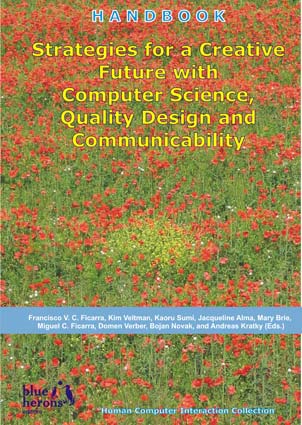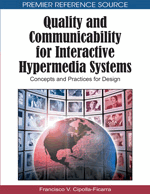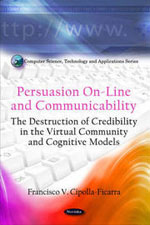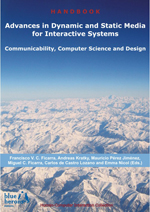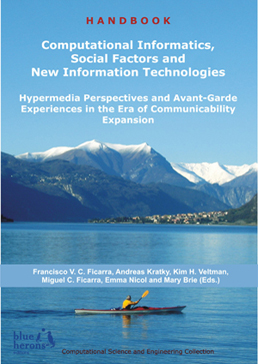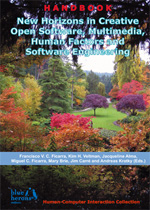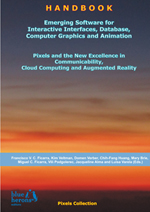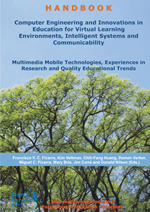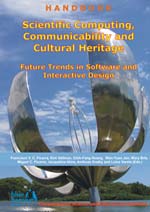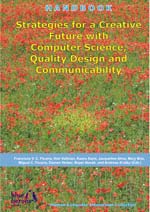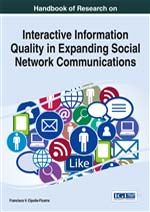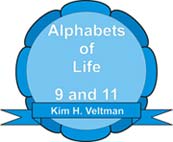Strategies for a Creative Future with Computer Science, Quality Design and Communicability
:: Human-Computer Interaction Collection ::
:: Revised Selected Chapters ::
Main Editor: Francisco V. C. Ficarra
Co-editors: Kim Veltman (Maastricht, Netherlands), Kaoru Sumi (Hakodate, Japan), Jacqueline Alma (Vancouver, Canada), Mary Brie (La Valletta, Malta), Miguel C. Ficarra (Spain and Italy), Domen Verber (Maribor, Slovenia), Bojan Novak (Maribor, Slovenia), and Andreas Kratky (Los Angeles, USA)
Editorial Assistant: Jim Carré (Willemstad, Curaçao) and Donald Nilson (Norway, Oslo)
Book Details
• ISBN: 978-88-96471-10-4 :: DOI: 10.978.8896471/104
• Publisher: Blue Herons Editions
• Location: Italy (Bg)
• Subjects: Creativity, Computer Science, Interaction, Communication, Design, ICT, History
• Subjects: New Media, Higher Education, Plagiarism, Semiotics, Linguistics, Open Source
• Subjects: Communicability, Self-Computer, KeyMail, Web, Jus Sanguinis, Cancer Therapy
• Subjects: HCI, Data Atomisation, Jus Solis, GPU Architecture, Heuristic Assessment, 3D
• Subjects: Quality, Languages, Information Systems, Business Intelligence, Security, CPU
• Subjects: Video, Teleconferencing, ETS, Privacity, VR, Noise, Sound, Technopia, Hardware
• Copyright: 2014
• Collection: Human-Computer Interaction
• Series volume: III
• Publication date: December, 2014
• Binding: Paperback
• Grade level: General
• Language: English
• Illustrations: Yes
• Colour: Yes
• Pages: 213
• Dimensions: 11.41x8.26x0.4 in. 1.21 lbs. :: 290x210x14 mm. 610 gr.
Preface
The progressive development of man is vitally dependent on invention. It is the most important product of his creative brain.
Nikola Tesla (1856 – 1943)
Since remote times, the great scientific discoveries have deep effects on all the aspects of our lives. In the 20th century, the mass media have catapulted humanity towards interactive communication in small size mobile multimedia devices. With the evolution of electronics, telecommunications and computer science to mention three examples, it has been apparent how scientific thought progresses thanks to a series of incremental steps, sometimes in an irregular way, and in diverging directions.
The investigations of Nikola Tesla are a good example in this regard. Besides, the capacity of creation, which the ancient Greeks attributed to the mythological gods, has been assigned in our days to the subconscious and other intellectual processes. However, in contrast to the works of Tesla, with a strong demonstrable scientific basis, nowadays we can come across the myth of visualizing in 3D the subconscious of people. Of course in this case it would be artistic experiments, with a certain medical basis, belonging rather to computer art than to the accuracy and the scientific rigor which medicine requires in the 21st century.
One of the key elements in the evolution of human kind has been creativity. Creativity is a term that is associated with the originality of solutions in the face of some given problems, which have led the scientific community to accumulate a series of discoveries and inventions along time which have revolutionized the daily coexistence of human beings. Creativity applied to the new or latest technologies, according to the perspective from which it is watched by the user of the on-line and off-line interactive systems, is without any doubt any of the environments where the knowledge of the different disciplines converge. The new technologies offer us a series of instruments to develop the potential of human beings with the goal of increasing the quality of life of millions of users of interactive systems in our global village. The relation of the triad computer science, quality design and communicability has proven very productive in the new millennium
Obviously in our days talking of scientific knowledge entails searching the educational bases that have trained the current protagonists of the sciences, that is, the training centres at a tertiary or university level, whether they are prívate, public and/or hybrid. Bases where the human/social factor at the moment in which they have been working in those classrooms have played an important role in the conformation of the research and development teams whether they are local and/or international. In other words, the current groups of scientists have been forged there.
Now they can veil over the common good of humanity or rather pursue a simple mercantilist end, which only benefits a tiny privileged elite. Aside from this socio-educative context the current work intends to be an interesting contribution to the advances and future trends of computer science, computer graphics, the scientific visualization applied to medicine, the resources of the graphic software which democratize the pixel, the learning process within the university classrooms which resort to a myriad novel strategies, the safety in the online communications, the human-computer interaction of the new millennium, the new social paradigms which may originate from unprecedented perspectives to rethink the global village defined by McLuhan. All of that without leaving aside the dynamic context of daily life in which it has been, is and will be immersed , the user of interactive systems. Currently this user is addressed towards a new era of communicability called “Quantic-Nanotechnological-Self-sufficient.”
Our effort focuses on finding the common denominator between the human-computer interaction, computer science, multimodal human-computer communication, and the global village, for example. That is, we address all those who are currently working to increase the quality of life of the human beings through the new technologies and all their derivations, wanting to know the last advances in the factual and formal sciences and that this handbook can serve as a compass to guide the current and future lines of research of the investigators belonging to the university, governmental bodies, the enterprises and industries of the private or public sector, etc.
Some research works collected in the book have been evaluated and corrected prior to publication in an anonymous way by a scientific committee. In some cases, said studies have been put forward orally, with their corresponding demos, that is, accompanied with practical/theoretical cases in international conferences, workshops and symposiums such as: MSIVISM 2014 (1st International Conference on Multimedia, Scientific Information and Visualization for Information Systems and Metrics), SETECEC 2014 (3rd International Conference on Software and Emerging Technologies for Education, Culture, Entertainment, and Commerce), CCGIDIS 2014 (4th International Symposium on Communicability, Computer Graphics and Innovative Design For Interactive Systems), HIASCIT 2014 (2nd International Conference on Horizons for Information Architecture, Security and Cloud Intelligent Technology), HCITOCH 2014 (5th International Workshop on Human-Computer Interaction, Tourism and Cultural Heritage), ADNTIIC 2014 (5th International Conference on Advances in New Technologies, Interactive Interfaces and Communicability) and HCITISI 2014 (2nd Argentine Conference on Human-Computer Interaction, Telecommunications, Informatics and Scientific Information). In the next section a short introductory presentation of the chapters that make up the current handbook is given:
The author of the first research work is the professor Kim Henry Veltman. In it and with the title of “A New History of Media, Scales and Disciplines” there is an excellent study of the evolution of the mass media with an extension towards the linguistic and semiotic context, which make it something unprecedented, brilliant and unique in its genre, to facilitate the understanding of the past, the present and the future of the social communication media. The study starts with the detailed evolution of the analogical media until reaching the digital. In this process they also stress the off-line and online multimedia until reaching the details of the interface. The quality and quantity of the data contributed by the author make apparent a series of novel points of view, which allow to open new ways for future research works, where originality and creativity are two terms that will be present. In other words, these pages are an obligatory reading for all those who want to know the precise origin and the trends in the immediate future of the communication media in the 21st century.
“Distance Communication: Trends and Challenges and How to Resolve them”, is a chapter submitted by Muhammad Sikandar Lal Khan and Shafiq ur Réhman. The authors of the research make apparent the importance of the videoconference in the elearning process. The study starts with a summary of the state of the art of the software and the hardware and simultaneously reveals solutions in the distance interactive communication process in relation to the experiences compiled by the authors. Later on are described the main qualities of the Embodied Telepresence System (ETS). A set of rhetoric questions allows to sum up masterfully the most outstanding points of the work. The images that accompany the text facilitate the understanding of the hardware used as well as the results obtained in the experiments carried out at the moment of interacting with those technologies. Finally it is possible to appreciate the potential of the use in the context of robotics.
The work titled “Noise When Communicating Verbal Messages in English by Native Spanish Speakers” has been developed by the following authors Pablo A. Alcaraz, Laura S. Gaytán-Lugo, and Sara C. Hernández. In it is made a wide study of the issue of physical noise in the language learning process in Mexico. The research reveals all the inconveniences in the educational process of the physical noises outside the classroom and their influence inside it, especially when the students are Spanish speakers in the learning process of a second language such as English. The correlation between the examples and the text allow the reader to gradually immerse himself in each one of the issues the authors approach. Finally, a long bibliography serves to orient all those interested in the current topic and who want to delve into the concepts developed along the pages.
The goal of the work “Measuring Intangible Objectives Using Business Intelligence (BI) Software: Perspective of the Student” is to evaluate the intangible assets that are reflected in the learning processes through the measurement of objectives. Its authors, Silvia V. Poncio, Luciana Semino, Martín Bellinzona, and Mariana Masiá, carried out systematic and non-systematic measurements made by professors. Besides, they considered the dimension of satisfaction of the student, which manifests itself in the learning process. The measurements obtained are the result of a set of specific activities developed and evaluated, which turn into an intangible capital for the development of learning processes. Said values are transferred to a Business Intelligence software which allows the dynamic visualization of each one of the studied aspects. In the case of the study and through the BI software can be visualized the graphics which depict the different conceptual, procedural and attitudinal evolutions of the pupils in a quarter, which refer to a specific subject (for instance, fifth year of systems engineering), each one with its evaluation criteria, numeric or not.
In “Improving Data Warehouse Security through Data Integrity and Confidentiality Preserving” its authors, Mohamed Ali Stouky and Habiba Chaoui Mejhed, stress the importance of improving the safety of the digital data. The analysis and presentation of the main and secondary topics follow a didactic structure of easy understanding, based on five key areas: Data Integrity, Data Encryption, Confidentiality, Privacy Preserving and Data Warehouse. In the chapter we can find several sets of study: the different existing architectures when we refer to data warehouses; an enhanced framework to achieve data warehouse security, the detail-techniques used to enhance data warehouse security; tests on the cryptosystems and data integrity methods selected, conclusions and future lines of research. Now the authors focus and delve into two aspects of data warehouse security: data confidentiality through encryption and data integrity. Besides, in the work are revealed interesting methods to increase the safety of the databases, for instance.
In the research “VISWES: A Virus Sequence Web Search System”, their authors, SeungHeui Ryu, WonAng Jang, DoHoon Lee, stress the importance of the use of open software for comparing oncolytic viruses sequences. This creative and economical solution presents an interactive system which could find a genetic sequence relationship among different viruses’ genomes and provides visualization function to display it. Through a data processing flow, the reader can speedily recognize how the architecture of the system is structured. In a didactic way the authors present tables and graphics to demonstrate the transcendence of the system as well as the obtained results. In other words, all the graphics and tables used in the chapter allow to have a global and quick vision of the issues treated. Now some of those visual resources are: Oncolytic virus list to compare sequence, a graph linked with red edge color which shows related sequences among porcine adenovirus A [NC_005869] and other virases; a phylogenetic tree of viruses whose sequence is correlated to pox virus, vaccinia virus and herpes virus genomes, a phylogenetic tree between adeno associate viruses and parvoviruses, a phylogenetic tree between pox virus, vaccinia vairus, variolar virus and CPXV004 CDS gene, ATTGCTGTTCTAG.., 214-mer in Cowpox virus [NC_003663], and Phylogenetic tree of adenoviruses.
The authors of the work “Rendering for Architectural 3D Scenes” are Bojan Novak and Domen Verber. In said resarch work its authors stress the importance of the Architectural 3D rendering, especially when it refers to computing power, energy and time. These three variables make up the central area of the research. Through a comparative study its authors analyze essential aspects such as: the difference between CPU and GPU architecture; the benchmark and cost calculations; comparative tables of rendering performance; cost of rendering in euros, among others. Each one of these aspects is accompanied by examples and bibliographical references so that the interested reader can widen such notions and conclusions of the comparison works. Works of comparison based on three different tests, for instance: rendering on 4 cores CPU, rendering on TITAN GPU, and rendering on TITAN + K20c GPUs. In the conclusions their authors stress the transcendence of the current study with the purpose of saving time and moreover costs at the moment of carrying out rendering of 3D scenes, for instance.
The authors of the research work “Originality and Organization of International Events in Information Systems, Human-Computer Interaction and New Technologies: A First Study of the Plagiarism, Stalking and Bullying” are Francisco V. Cipolla-Ficarra, Jim Carré and Donald Nilson. They analyze the presence of originality in the context of the international events through some techniques of heuristic evaluation. Simultaneously, it studies how innovative creativity is destroyed in the European scientific sector of the ICT, the digital divide among the citizens increases and the benefits of the democratization of the results of the sciences among the population slows down. The authors present real cases of study, where the education, research and politics are real antimodels to be followed by the European potential students and professionals. Those are international events apparently oriented towards R&D but implicitly and explicitly they are based on behaviour patterns of plagiarism, stalking and bullying of their members. That is, actors whose deeds are included in the system of international civil and penal law. The cases of study in the current work are focused on university contexts, belonging to the regions of Spain, Portugal and Italy, for example. Departments oriented towards the new technologies, computer science, human-computer interaction, cognitive models, etc have received special consideration. The study not only has been able to establish radial maps of attacks and smear of the sciences, their members, whether it is within or outside the borders of the state to which they belong, and also the manipulation exerted over the academic and/or scientific curricula.
“Natural Thoughts, Freedom and Atomic Networks” is the title chosen by its author, Alan Radley, who presents us with a novel vision of understanding the computers in daily life called “technopia”. It is a point of view that surpasses by far the mercantilist notion of “humanistic computing”, currently prevailing in a myriad university education centres, public, private and hybrid. In his research he develops and presents splendidly expressions and terms such as: Techno-rights, Theory of Natural Thoughts, Private-Thoughts, Open-Thoughts, Secret-Thoughts, Implanted-Thoughts, Self-Computer and Atomic Networks. He approaches each one of these notions in a detailed way and from a social point of view as well as technological. A wide variety of examples allows to establish the link among the different sciences and/or disciplines to which he refers. Finally, and in the domain of the software for a new paradigm of communication among human beings, the author presents a new system for electronic messages called “KeyMail”.
In the work “The Disintegration of the Informatics, Social Sciences and Humanities in European Union” a boomerang effect of creativity in scientific research is presented, starting from the butterfly effect (redundancy, ambiguity and vagueness) in the Spanish and Italian university education. The author has compiled for decades analogue and digital information which makes apparent how the integration of highly qualified professionals in the European university team works is impossible because of reasons of “jus sanguinis” and/or “jus solis”. Besides, the main destructive strategies are presented belonging to university groups of the public, private and hybrid teaching, in order to eternally demoralize all those who are excluded from these two sets. Simultaneously, the study focuses on the high cost that it means for a state to have destroying agents in their educational systems, who have a very negative influence not only in the training of the future generations, but also in the economic domain, in view of the phenomenon of non-integration in the society of a potential highly qualified staff. Also is presented a guide or vademecum to avoid these backward study centres in the Old World, although they are related directly or indirectly with the new technologies. Finally, we make known a first robot profile of those who are called in the current work “destroyers of creativity in scientific research”.
Francisco V. C. Ficarra
Lanzarote, Spain (December 2014)
Partial Content On-line (pdf format)
• Front Cover (here)
• Preface :: Acknowledgment (here)
• Chapters :: Final Remarks :: Author Index :: Keywords Index :: References ... (here)
• Back Cover (here)
Additonal Handook Info
• Only paper copy – no digital book on-line and/or off-line –
• Special Price € 95 (expedition cost not included) ... e-Commerce :: Info Form
Welcome to Blue Herons Editions!
The origin of this publishing project is to be found in the Canadian lands, where nature presents itself generous in many places of its wide geography. More...
Education, Communicability, Design, Computer Science, HCI, Computer Graphics and Computer Animation:
We focus on education and new technologies with 34 years long experience. More...
Literature and Journalism:
Intersection between universal literature, local new journalism (true stories), sociology and legal immunity. Two collections:
- Casoncelli Bergamaschi
It is a typical bergamasque dough filled with meat, similar to the raviolis. More...
- Menjar Blanc & Black
It is a typical sweet of the Catalan coast and the Balearic Islands. More...
Others New Releases:
See all others new releases in books, CD, DVD, etc. More ...
Call for Papers: ADNTIIC 2015 :: HCITOCH 2015 :: SETECEC 2015 :: HIASCIT 2016 :: CCGIDIS 2015 :: IPCTIIC 2015 | HCITISI 2015 :: MSIVISM 2016 :: RDINIDR 2015

